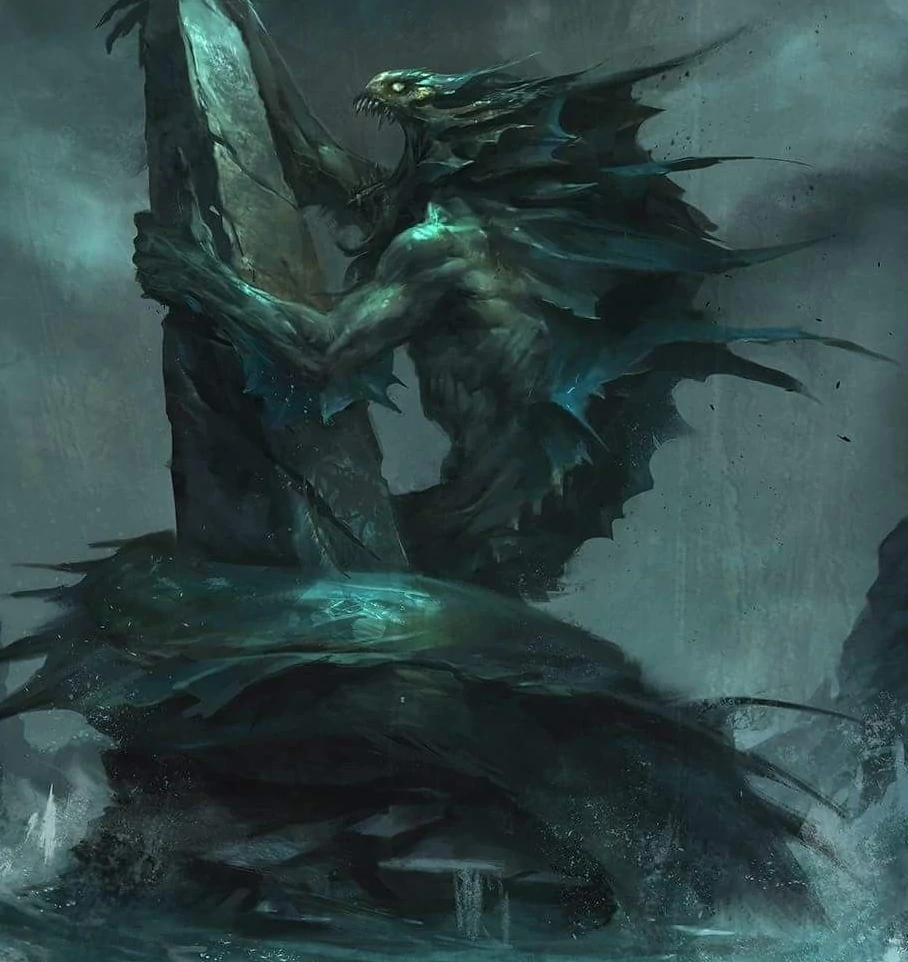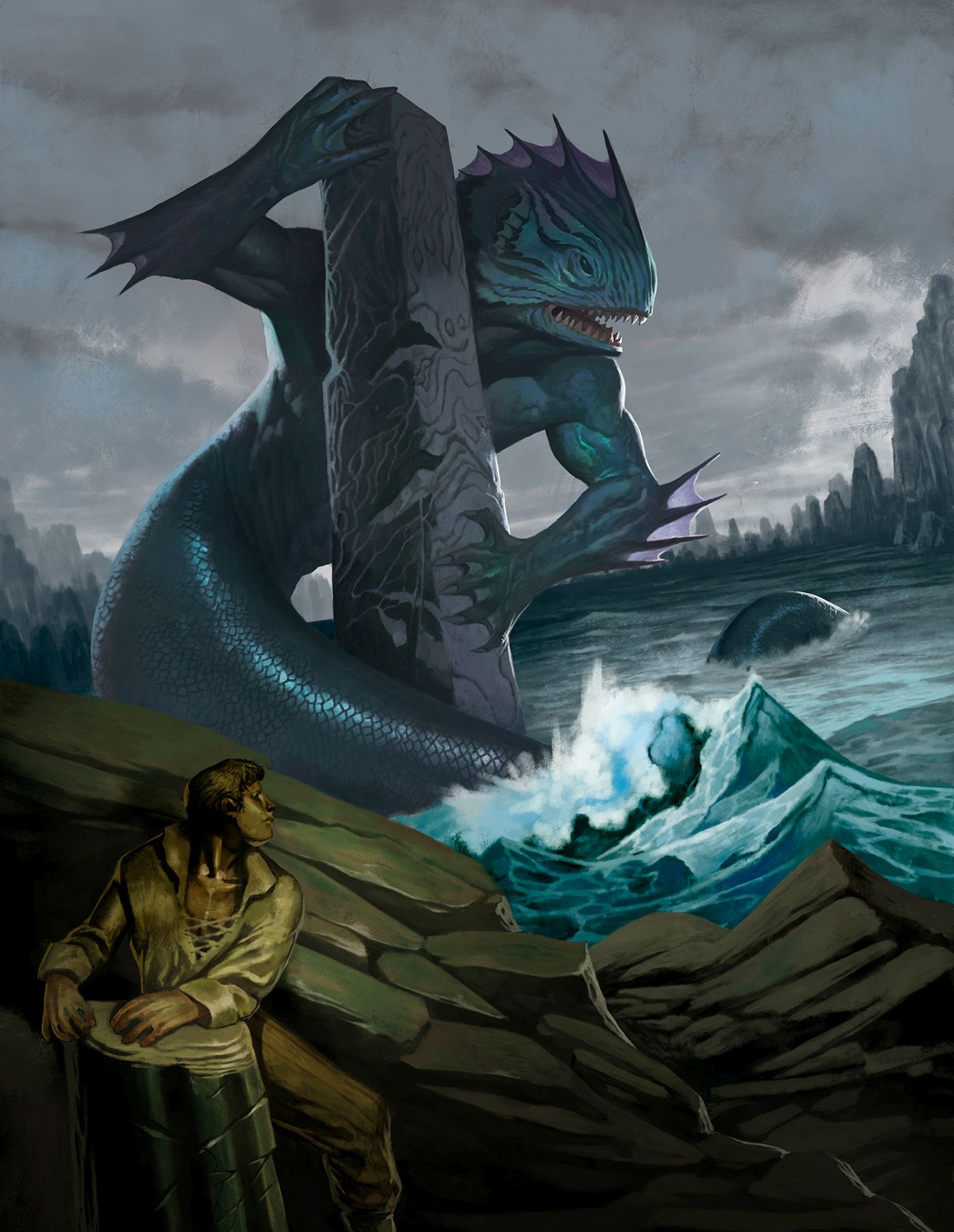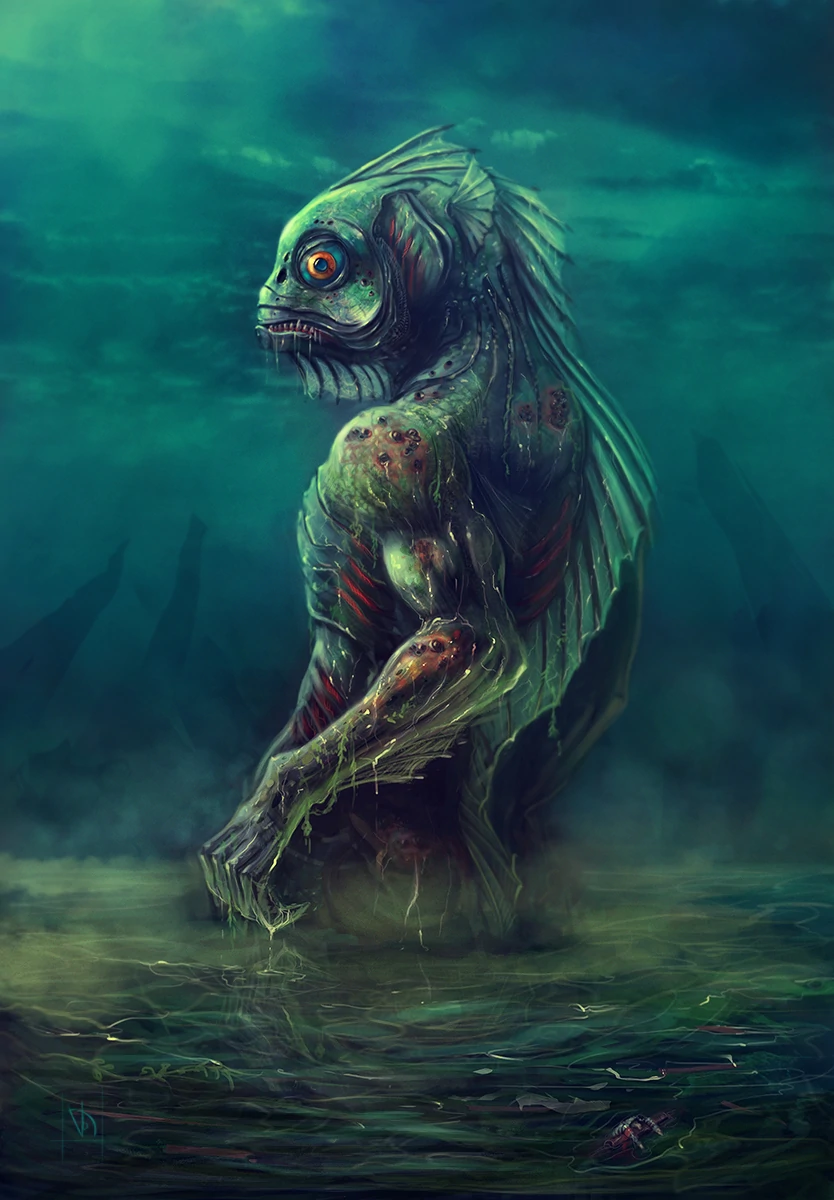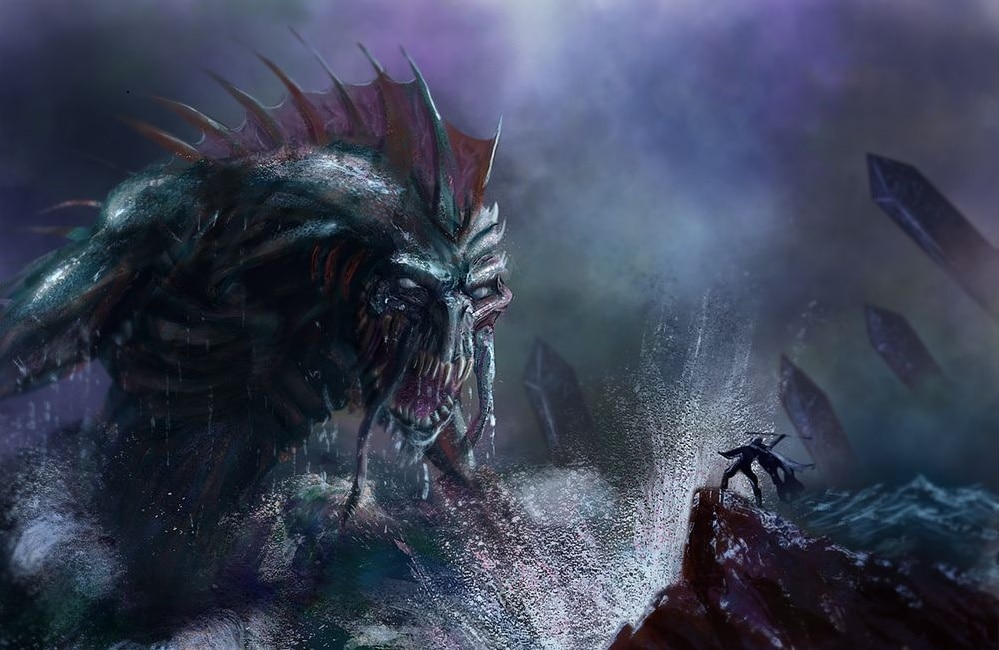H.P. Lovecraft, the creator of horror as we know it today, has created and written numerous terrible entities, bringing them to life like no other writer. His works elicit admiration while simultaneously eliciting a primitive, frightened response. We have talked about his different monstrous creations extensively on this channel, but today we will focus on the big ancient Dagon.
In July of 1917, H. P. Lovecraft published the short story Dagon. It was one of his first adult stories, and it was first published in The Vagrant issue #11 in November 1919. In October of 1923, Weird Tales published an article on Dagon. Some belief Dagon to be one of Lovecraft’s most forward-thinking tales. The title is a nod to Dagon, a Great Old One who would appear in later works, and it has several elements that foreshadow future works like Cthulhu: The Call of Cthulhu and The Shadow Over Innsmouth.
The known history of Dagon is pretty fascinating. Dagan was a West Semitic god of crop fertility who was widely revered in ancient Mesopotamia, and his name was also spelled Dagon. Dagan was the Hebrew and Ugaritic common term for “grain.” and he was said to be the fabled inventor of the plow.
According to tablets discovered in Ras Shamra in ancient Ugarit, his cult dates back to roughly 2500 BC, and he was the father of the god Baal. Dagan had a large temple at Ras Shamra, as well as numerous sanctuaries in Palestine, notably those at Beth-Dagon in Asher, Gaza, and Ashdod, where he was particularly venerated as a Philistine god. At Ras Shamra, Dagan appears to have ranked second only to El, the supreme god, though his abilities as a god of vegetation appear to have been transferred to Baal by 1500 BC.
Let us take a closer look at who he is and what he has left in the history of mankind.
Who Is Dagon?

Dagon, sometimes known as Father Dagon, is a creature from the Cthulhu Mythos created by H.P. Lovecraft. He makes his first appearance in Lovecraft’s short story “Dagon,” and he appears frequently throughout the mythos. Dagon is a hideous humanoid creature over fifty feet tall with a fish-like visage, flapping gills, and a scaly, slimy hide, resembling a massively gigantic Deep One. The appearance is akin to most Deep One descriptions and quite unfathomable to the human mind and eye.
However, there is significant controversy as to whether Dagon is a truly Great Old One or simply a Deep One who has grown to monstrous dimensions, as some Deep Ones grow in size throughout their lives. The Deep Ones’ “holy trinity,” which includes Dagon, his spouse Mother Hydra, and Great Cthulhu himself, is a trio of entities regarded as gods by that oceanic species.
Thus, Dagon enjoys the same status as Cthulhu, arguably one of the most famous creations of Lovecraft. In addition, Cthulhu has entrusted Dagon and Mother Hydra with the guardianship of his “daughter” Cthylla, and the pair are thought to be keeping watch over her in one of their great underwater cities somewhere in the North Atlantic, though one eyewitness account places Dagon on an island in the Pacific Ocean, east of Java. This means that Dagon enjoys quite the important position with regard to Cthulhu and the Cthulhu mythos.
To add to his importance, Father Dagon and Mother Hydra are also worshipped by the Esoteric Order of Dagon, a cult of humans and human-Deep One hybrids, in addition to their Deep One followers.
However, since the United States government enacted its purge of Innsmouth, this cult is much smaller than it was in the past and much more secretive about its practices. However, we all know when there is a cult, there are all kinds of sacrifices and occult happenings. Most importantly, having a cult following shows the true significance and powerful presence of Dagon.
In early 1980, the Wilmarth Foundations’ Project X targeted Dagon as one of its objectives. The operation’s goal was to eliminate Father Dagon, Mother Hydra, and Cthylla, but it was unsuccessful, and the three were able to flee to safety. It definitely is not easy to kill the big three deities of the seas.
It is interesting to know that Dagon was most likely modeled on the ancient Mesopotamian god of fish, fishing, and fertility, who was reputedly the god of fish, fishing, and fertility. The Philistines were an Aegean people who settled on the southern shore of what is now Israel in the 12th century B.C. They were a Canaanite community. Their pagan god Dagon, sometimes known as Dagan, was a fertility god who later evolved into a significant Semitic god.
Grain and fish, both symbols of fertility and multiplying, were used to depict Dagon. He may very well be the original merman, predating even the merfolk of Greek mythological traditions. He is often represented with the torso of a man and the tail of a fish. Dagon’s root, dag, means fish in Hebrew Semitic dialect, and Dagan or Dagon is a cute nickname for a small fish. According to some linguists, the term means “grain” in the ancient Canaanite language.
Dagon first appears in records dating from 2500 B.C. at Mari, Syria, in ancient Mesopotamia. Later, he was described as a protector and warrior deity in Assyrian and Babylonian inscriptions, as well as in records from the ancient Syrian port city of Ugarit. In this old location, there was a temple dedicated to him. Along with El and Baal, he had risen to become the pantheon’s third deity at the time. In the city of Ugarit, archaeological expeditions also discovered a Baal temple.
Dagon’s consort was once known as Belatu, which meant “woman” in Greek mythology. Other mythologists link him to the goddess Nanshe, a fertility and fishing goddess who was also Enki’s child. She is Astarte’s fabled sister.
The ancient Dagon appears to have played an important role in the lives of the ancient Philistines, Assyrians, Babylonians, and other Canaanites. His symbolism pervades Catholicism, and he is named multiple times in the Hebrew Bible. Dagon may have been the first merman, and he was followed by a slew of other fish gods in later mythology. Dagon is still a mystical figure in popular culture today. He’s had a long and illustrious career, dating back to the 12th century B.C, and also seems to be one of the main influences for Dagon, the great old one.
Dagon’s Description in Myths and Folklore

Considering that Dagon was modeled on the ancient God, there is a sufficient amount of myth and folklore attached to him and his existence. Dagon originated as a fertility god in Northwest Semitic Mesopotamia and grew into a great Northwest Semitic god of grain and fishing. The grain is seen as a symbol of fertility.
The Amorites and the cities of Ebla and Ugarit revered him across a broad geographical area, from Mesopotamia to Syria. He was possibly a significant divinity in the Philistine pantheon. Another hint to his realm is that his name is tied to an old Semitic root word for “grain.”
Around 2500 BC, Dagon first appeared in the Mari manuscripts. His precise functions, however, are unknown because he is not well documented in Levantine mythological literature and only seldom in Mesopotamian literature. In particular, he delivers a speech describing Ninurta’s exploits in the Assyrian story of Anzu. In some accounts, he is linked to the underworld, and it is stated that he keeps the seven children of Enmearra with him.
He also enjoys a Biblical appearance as well, as Dagon is referenced in the Old Testament as a great Philistine god who is defeated by the Hebrew God. The Ark of the Covenant is captured by the Philistines in battle and placed in Dagon’s temple as a symbol of his victory. Dagon’s statue, on the other hand, is face down on the floor in the morning. It was put on its feet by the villagers, but the next morning it was back on the floor, its head and hands broken off.
Thus, it is safe to say that Dagon enjoys space in myths and folklores that date back to his ancient origins.
Dagon – A Short Story By H. P. Lovecraft

As mentioned before, Dagon was first mentioned in a short story of the same name by H.P. Lovecraft. W. Paul Cook, the publisher of the amateur press periodical The Vagrant, urged Lovecraft to continue writing fiction after reading his juvenalia in 1917. Lovecraft wrote two stories that summer: The Tomb and Dagon. Part of the story was inspired by a dream he experienced.
He subsequently commented that he imagined that whole horrific crawl, and could still feel the goo pulling him under. Lovecraft may have been influenced by Irvin S. Cobb’s Fishhead, a story about a bizarre fish-like human, according to critic William Fulwiler. Lovecraft may have adapted the story’s subject of an ancient prehuman race that would one day rise to conquer humanity from Edgar Rice Burroughs’ At the Earth’s Core, according to Fulwiler.
The storyline is about a troubled, morphine-addicted man who is planning to commit himself because of an incident that happened early in World War I when he was a merchant marine commander which left an indelible mark on his psyche. The story goes that his cargo ship was captured by a German sea-raider in one of the most open and least visited sections of the broad Pacific, according to the unknown narrator.
He escaped in a lifeboat and wandered aimlessly across the water south of the equator until he found himself stuck on a slimy expanse of infernal black mud which sprawled around him in endless undulations as far as he could see.
The area was filthy, with decaying fish corpses and other less descriptive items jutting from the awful mud of the endless plain. He theorizes that this landmass could represent a piece of the ocean floor pushed to the surface by a volcanic eruption, exposing regions that had remained hidden beneath unfathomable aquatic depths for uncountable millions of years.
He sets out on foot to reach the sea and probable rescue after waiting three days for the seafloor to dry up enough to walk on. He arrives at his destination, which is a “hummock” that turns out to be a mound on the brink of an immeasurable hole or canyon, after two days of walking.
As he descends the slope, he notices a big white stone item, which he quickly recognizes as a well-shaped monolith whose tremendous bulk had known the workmanship and possibly the adoration of living and thinking creatures.
The monolith, which sits adjacent to a water channel at the chasm’s bottom, is covered in strange hieroglyphs mostly consisting of conventionalized aquatic symbols such as fishes, eels, octopuses, crustaceans, mollusks, whales, and the like.” “Crude sculptures” portray grotesque animals with webbed feet, glassy bulging eyes, and horrible faces are also available.
As the narrator gazes upon the monolith, a giant, Polyphemus-like, and vile creature emerges from the sea. It rushed like a colossal monster of nightmares to the monolith, over which it flung its gigantic scaly arms, all the while lowering its horrible head and letting forth specific measured moans. The mariner, terrified, returns to his abandoned boat and barely recalls a “big storm.”
His next memory is that of being transferred to a hospital in San Francisco after being rescued in the middle of the ocean by a US ship. There have been no reports of Pacific earthquakes, and he doesn’t expect anyone to believe his unbelievable story. It is so deeply unfathomable that he simply knows that no human would believe it even if he tried his level best to make them understand unless they also experienced the heart-stopping horror that he had.
As it is with these monsters, he is haunted by visions of the creature, which become especially frequent when the moon is gibbous and waning, and he expresses his fears for humanity’s future by saying that he can’t think of the deep sea without shuddering at the nameless things that may be crawling and floundering on its slimy bed right now, worshipping their ancient stone idols and carving their own detestable likenesses on submarine obelisks of water-soaked granite.
I fantasize about a day when they will rise above the billows, dragging the remnants of wretched, war-weary humanity in their reeking talons —of a day when the land will sink and the dark ocean floor will rise amid universal chaos.
He declares himself ready to kill himself when the medicine that has given him “transient surcease” runs out and heartbreakingly enough, the entire narrative is revealed to be part of a suicide note. The narrator rushes to the window after hearing a commotion at the door, as of some enormous slippery figure lumbering against it.
Dagon Influence On History

The mythological and historical existence of the god Dagon has been recorded in history. The holy tablets on which the Ten Commandments were written were kept in the Ark of the Covenant. During their 40 years in the desert, the Israelites took the ark with them. The splitting of the waters of the Jordan River, which allowed them to cross into Canaan, is one of the many miracles associated with the ark.
According to biblical legend, the Philistines captured the ark and transported it to Ashdod, their capital, to be placed in the Dagon temple. The next day, they discovered Dagan’s idol had fallen flat on its face. They replaced the statue, thinking it was a mistake. They returned the next day to find the statue had been decapitated.
Shortly after, the city was struck by a mouse epidemic, and the residents had hemorrhoids! As a result, the Philistines relocated the ark to Gath, and subsequently back to Ekron. Each of the cities was also plagued. The ark, not to mention the rodents and vermin that accompanied it, became a real pain in the neck. The Philistines eventually returned it to the Israelites with gifts after seven months.
In the story of Ichthys, the fish used as a symbol for Jesus is known as an ichthys, which means fish. It is also an abbreviation for the words Jesus Christ, Son of God, Savior when written in the Greek alphabet. Fish symbolism predates the cross, and it is thought that early Christians borrowed some of their symbols from the ancient pagan Mesopotamians.
The Catholic Pope and bishops wear a towering headgear known as a miter, which resembles Dagon’s headdress. It has a split top and a pointed shape, which some believe resembles the head of a Dagon with an open mouth. Some speculate that the Pope wears it to continue the legacy of the mitre worn by the first pope who was privy to Dagon’s secrets.
That is all we know about Dagon, the great old, deep one, and where his origins lay. As it is with Lovecraftian entities, the lesser we know about them, the better because what is actually scary is what is unknown and lurks in the shadows or in this case, in the depths of the ocean.
